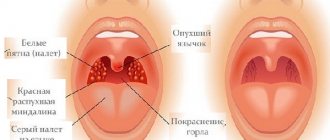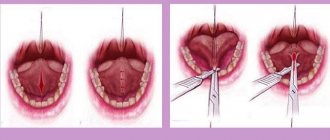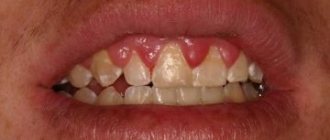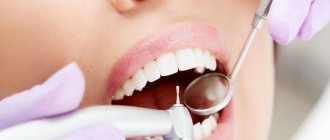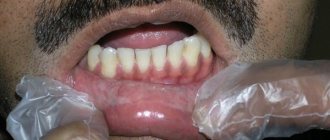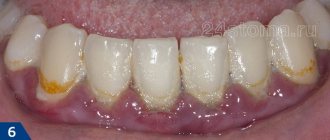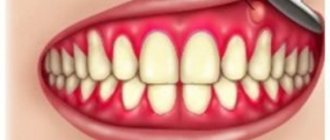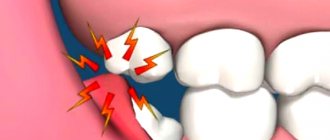Tongue cancer is a malignant tumor of the tongue, which originates from the cells and mucous membrane of the epithelium. This disease is characterized by diffuse or local compaction of tissue and the formation of ulcers and neoplasms on the surface of this organ. Such tumors of the tongue are characterized by rapid growth and metastasis to the lungs, bones, lymph nodes, liver and brain. Diagnosis of tongue oncology is carried out according to examination, smears, palpation, biopsy material, and radiography. To determine distant metastases, MRI of the brain, ultrasound of the liver, X-ray of the lungs, and scintigraphy of the skeleton are performed. Treatment for tongue cancer consists of a combination approach of chemotherapy, radiation therapy and surgery.
Varieties
There are two main classifications of tongue tumors: according to the form of the disease and according to histological structure. Let's look at them.
The forms of tongue cancer are as follows:
- Ulcerative . With this form, an ulcerated, bleeding tumor is found on the tongue.
- Papillary . A dense growth forms on the tongue on the so-called “pedicle” or on a wide base.
- Infiltrative . The tumor is located deep within the organ.
Classification according to histological structure:
- adenocarcinoma;
- squamous cell carcinoma (the most common - 95% of cases);
- basal cell.
Tongue cancer - treatment in Moscow
In the presence of tongue cancer, timely diagnosis of the disease and treatment started as early as possible are necessary, which will give the patient a chance for a full recovery. High-quality diagnosis and effective treatment of tongue cancer in Moscow at the oncology clinic will provide the patient with the opportunity to live a full life. The clinic has high-tech equipment and a staff of qualified specialists at its disposal. Rehabilitation is available to patients at the oncology clinic.
The price of treatment for tongue cancer at the oncology clinic of the Yusupov Hospital in Moscow varies from 5 to 20 thousand rubles, depending on the complexity of the disease.
Symptoms
Symptoms vary depending on the stage of the disease. The first signs at the initial stage:
- feeling of tongue numbness;
- discomfort in the oral cavity;
- wounds that do not heal for a long time;
- a red or white spot on the tongue.
Further, when the stage becomes later, or advanced, patients note the following signs of the disease:
- ulcers that do not heal for a long time;
- voice change;
- enlarged lymph nodes in the neck;
- excessive salivation;
- disturbance of movements of the lower jaw.
Late stages of tongue tumor development are characterized by symptoms such as:
- difficulty swallowing;
- persistent severe pain in the mouth, radiating to the neck, throat, temples, ear;
- bleeding in the mouth in the absence of injury;
- bad breath associated with the destruction of soft tissues.
When a tumor metastasizes and spreads to other organs, the symptoms are as follows:
- nausea;
- weakness, fatigue;
- causeless weight loss;
- specific signs that an organ, such as the liver or lungs, is affected.
Classification of tongue cancer
Tongue cancer, depending on location, is divided into the following types:
- cancer of the lower surface and cancer of the base of the tongue occurs in 10% of cases;
- tongue root cancer occurs in 20% of cases;
- Cancer of the body of the tongue occurs in 70% of cases and is most often localized on the middle of the lateral surface of the body of the tongue.
In modern medicine, there is a macroscopic classification of tongue cancer, which is characterized by an endophytic (infiltrative or infiltrative-ulcerative) and exophytic clinical form (ulcerative or papillary). According to this classification, 95% of tongue cancer is classified as squamous cell cancer of the tongue. Other histological forms, such as basal cell lymphoepithelioma or adenocarcinoma, are very rare.
Today, the clinical picture of tongue cancer is determined depending on the stage of its development. The following degrees of development of tongue cancer are distinguished according to ICD 10:
- For the first degree, it is typical that the size of the tumor under the tongue is about 1 cm and spreads inside the mucous membrane, but does not metastasize;
- The second degree is characterized by an increase in size of neoplasms on the tongue, germination and damage to soft tissues. In this case, the tumor does not extend below the midline of the tongue;
- The third stage of cancer development is characterized by the presence of single regional metastases. The tumor itself does not increase in size;
- The fourth stage of development of tongue cancer according to ICD 10 is characterized by the presence of an ulcer or tumor that spreads beyond the midline of the tongue and affects the bottom of the tongue cavity, resulting in the development of cancer under the tongue;
- At the fifth stage of development of tongue cancer according to the ICD, a large number of mobile regional metastases appear, the tumor spreads further throughout the body of the tongue;
- At the sixth stage of development of tongue cancer, the tumor affects almost the entire part of the tongue or covers the entire organ completely. There is distant metastasis, damage to the bones of the facial skeleton occurs.
Diagnostics
To accurately diagnose tongue cancer, laboratory and hardware tests are required. However, first of all, the patient should consult an ENT oncologist, who will give the necessary directions. Among the diagnostic methods:
- blood for tumor markers, other laboratory blood tests;
- biopsy of the affected area followed by histological examination;
- revision (revision) of the biopsy;
- MRI of soft tissues of the neck and face using contrast;
- CT scan of the neck and head with contrast;
- PET-CT.
Prevention and prognosis
The main goal of prevention against tongue cancer is to give up bad habits such as smoking and alcohol. Chronic injury to the mucous membrane of the tongue should also be avoided, including timely treatment of chipped teeth, high-quality treatment of fillings, and proper installation of dentures.
Be sure to visit your dentist regularly to have your mouth examined and look for any changes. With timely diagnosis, the prognosis for recovery is more expected. With timely treatment, life expectancy, according to research, ranges from 5 to 15 years.
Methods of treating the disease
Treatments for this type of cancer include surgery, radiation therapy, and chemotherapy. Let's consider these methods separately.
Surgery
The main method of treatment is resection (removal) of the tumor. The principle of the surgical technique is to remove a malignant tumor from the patient. Surgery is always performed, except in cases where the tumor is inoperable.
Operation options:
- Gentle resection, in which the tongue or most of it is preserved.
- Radical removal (the operation is called glossectomy, this is the total removal of the tongue).
- Together with glossectomy or after it, reconstruction of the tongue is often performed - one-stage plastic surgery with a skin flap. This intervention allows you to preserve the functions of the removed organ.
Radiation therapy
Radiation is designed to destroy cancer cells or slow their growth. For small tumors this is the main treatment method. Radiation can also be given before surgery (to reduce the tumor) and after it (to avoid relapse). In later stages, the technique is used as palliative therapy, that is, it alleviates symptoms.
Chemotherapy
This is a systemic therapy that aims to destroy malignant cells throughout the body. Chemotherapy is given before surgery (to shrink the tumor) or after it (to avoid relapse).
Therapy results
Cancer is not a death sentence, although it looks very dramatic. Statistics and clinical data indicate that if adequate treatment is started in the first and second stages of the disease, the recovery rate ranges from 59 to 93 in the first stage and up to 62 in the second stage.
If treatment was started in the third stage, then cure is possible in 37 percent of patients. At stage 4, the prognosis for recovery is extremely unfavorable. A complete cure is impossible to achieve. There is no statistically reliable data on recovery in advanced forms. The last stage is characterized by a severe course, and treatment is more aimed at preserving the vital functions of the body; a cure cannot be achieved.
Stages of the disease
Stages of tongue cancer
We offer you a table of correspondence between tongue tumor stages and clinical TNM classification, which uses the following designations:
- T – indicates the primary tumor: Tx – the primary tumor cannot be assessed;
- T0 – no data on the primary tumor;
- Тis – cancer in situ (pre-invasive stage);
- T1-T4 – the primary tumor is enlarged and/or widespread.
- Nx – regional lymph nodes cannot be assessed;
- M0 – no distant metastases;
Correspondence table for stages of tongue cancer TNM classification
| TNM stage | |
| 0 (carcinoma in situ) | Tis, N0, M0 |
| I | T1, N0, M0 |
| II | T2, N0, M0 |
| III | T3, N0, M0 or T1-T3, N1, M0 |
| IV | 4a: T4a, N0 M0 or T4aN1, M0 or T1-T4a, N2, M0 4b: T4b, any N, M0 or any T, N3, M0 4c: any T, any N, M1 |
Reasons for appearance
There are a number of predisposing factors to the development of tongue cancer. Let's look at them in more detail:
- Tobacco and alcohol . When smoking, the risk of developing this disease is influenced by how much, often and for how long a person smokes. Those who have been diagnosed with this type of cancer need to completely stop smoking, since continued tobacco use increases the risk of developing cancer of another location. Of 10 patients with malignant neoplasms of the oral cavity, 7 are susceptible to alcohol dependence. The combination of alcohol and smoking increases the risk of oral cancer by 100 times compared to people who do not drink or smoke.
- Human papillomavirus (HPV) . The incidence of oral cancers associated with HPV has increased in the last decade. According to research, cancer associated with HPV affects mainly young patients who do not have a long history of drinking alcohol and smoking. Now many doctors associate the prevalence of HPV in the last two decades with people's passion for oral sex.
- Floor . Men suffer from this type of cancer 2 times more often than women, which may be due to frequent consumption of alcoholic beverages and smoking.
- Age . Oral cancer is more often diagnosed in patients 55-60 years old. This is due to its slow development. However, the presence of HPV changes this situation.
- Poor nutrition . According to several studies, the risk of developing such cancer increases with a deficiency of vegetables and fruits in the diet.
- Weak immune system . The risk increases in people who have congenital or acquired immunodeficiency, as well as in those who take drugs to suppress the immune system (this is necessary after an organ transplant).
- Graft versus host disease (GVHD) . This reaction is typical for the condition after stem cell transplantation: this is how the body reacts to foreign donor cells. Oral cancer can develop within 2 years.
- Lichen planus. This disease most often affects the surface of the skin, but can also appear as white spots and lines on the oral mucosa. Increases the risk slightly.
- Bowen's disease. This is an obligate precancerous condition, the tumor is located inside the epithelial layer. Sooner or later it transforms into malignant.
Organ characteristics
The root of the tongue is located deep in the mouth, namely in the recess of the lower part of the palate between the teeth. It, like the rest of the tongue, is covered with a mucous membrane. The root of the tongue is its base and consists of several muscles that continue into the body of the tongue. The tongue is considered the strongest muscle of the body and combines 8 different muscles that are woven together and complement each other.
On the outside, the tongue is covered with a mucous membrane, which consists of papillae of various types. It is the presence of papillae that helps to sense taste and starts the digestion process.
The papillary layer forms a rough surface on the tongue, on which plaque from food or bacterial activity is quickly deposited. It is the quality and color of plaque that signals disturbances in the functioning of the body.
Often, based on the condition of the tongue, it is possible to determine the presence of diseases of individual organs for further examination and diagnosis, therefore, during the examination, the therapist must note the color of the tongue.
Observation
After treatment, you need to undergo regular examinations, their frequency depends on how many years have passed since entering remission.
- In the 1st year - every 1-3 months.
- In the 2nd year - every 2-6 months.
- In 3-5 years - every 4-8 months.
- In the 6th year and thereafter – annually.
The following manipulations and examinations are carried out as control tests:
- medical instrumental examination of the oral cavity, peripheral lymph nodes;
- examination by a dentist if radiation therapy was performed in the oral cavity;
- endoscopic examination of the pharynx and oral cavity;
- for patients who have previously smoked - MRI (CT) of the soft tissues of the neck with contrast, CT of the chest and abdominal cavity with contrast. If necessary, PET with glucose, osteoscintigraphy.
